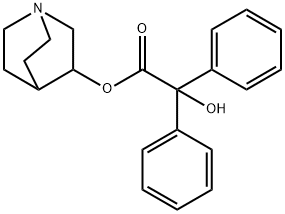3-Quinuclidinyl benzilate
Synonym(s):(±)-QNB;(±)-Quinuclidinyl α-hydroxydiphenylacetate
- CAS NO.:6581-06-2
- Empirical Formula: C21H23NO3
- Molecular Weight: 337.42
- MDL number: MFCD01658356
- EINECS: 233-250-6
- SAFETY DATA SHEET (SDS)
- Update Date: 2024-12-18 14:07:02

What is 3-Quinuclidinyl benzilate?
Description
The 3-quinuclidinyl benzilate (3-QNB) was first discovered by Hoffmann-La Roche in 1951 during research investigation that involved development of antispasmodic agents, resembling atropine, for treating gastrointestinal conditions. Soon after, the US Army investigated 3-QNB under the name of EA2277 agent and was standardized for use in chemical munitions in 1961 under the name agent of BZ. The United States declared complete destruction of its stockpile of BZ by 1989. Moreover, Agent 15 is speculated either to be identical to BZ or a closely related derivative, and has similar physicochemical properties as BZ. In 1998, Agent 15 was speculated to be stockpiled by Iraq but later on intelligence reports did not find any conclusive evidence for such claim1. The BZ is a glycolate anticholinergic chemical related to atropine, scopolamine, and, hyoscyamine. It is odorless, nonirritating, and is stable in most solvents. It has a half-life of 3–4 weeks in moist air and is extremely persistent in soil, water, and most surfaces. BZ has a slow onset and a long duration-of-action. The rate of BZ action climaxed after 9.5 h of exposure and the duration-of-action could last up to 96 h. Moreover, most of the causalities of BZ exposure will require physical restraint and continuous monitoring to prevent self-injury and paranoia symptoms during recovery2. Recent speculation about the usage of Agent 15 in Syrian civil war had been reported but no confirmation findings had been established3.
Chemical properties
Colourless solid
The Uses of 3-Quinuclidinyl benzilate
3-quinuclidinyl benzilate(BZ) is a nonlethal chemical warfare agent that following a delayed onset is incapacitating and causes severe hallucinations. US Army intended to use BZ in critical point situations such as special operation, incapacitating adversaries during raid, and overcoming fortified field positions. Medically, BZ is used as a muscarinic receptor antagonist.
General Description
Colorless liquid, odorless to fruity.
Environmental Fate
BZ acts by blocking the action of acetylcholine on the central
and peripheral nervous systems. It is a tertiary amine and
crosses the blood–brain barrier. BZ on acute exposure
increases both heart and respiratory rates, dilates the pupils,
and causes paralysis of the eye muscles necessary for near
focusing. It also causes dry mouth and skin, elevates body
temperature, impairs coordination, and causes flushing of the
skin, hallucinations, stupor, forgetfulness, and confusion.Within 15 min to 4 h following exposure, the principal effects
are dizziness, involuntary muscle movements, near vision
difficulty, and total incapacitation. From 6 to 10 h after
exposure, the effects are psychotropic and full recovery is expected after 4 days.
The peripheral nervous system effects are considered as
understimulation of the end organs. This decreased stimulation
of eccrine and apocrine sweat glands in the skin results in dry
skin and a dry mouth, and is considered ‘dry as a bone.’ The
reduction in the ability to dispel heat by evaporative cooling
decreases sweating, and the compensatory cutaneous vasodilation
causes the skin to become warm or ‘hot as a hare’ and ‘red
as a beet.’ This is similar to the atropine flush. The decreased
heat loss also results in an increased core temperature.
Toxicity evaluation
QNB-BZ or Agent 15 has been tested on different surfaces by the US Army Medical Research Institute of Chemical Defense and the overall conclusion was that QNB-BZ persists as a parent molecule for an extended period of time reaching 72 h4.
Properties of 3-Quinuclidinyl benzilate
| Melting point: | 164.5°C |
| Boiling point: | 473.72°C (rough estimate) |
| Density | 1.1644 (rough estimate) |
| refractive index | 1.5614 (estimate) |
| storage temp. | 2-8°C |
| solubility | chloroform: but decomposes within 24 hrssoluble |
| form | powder |
| pka | 11.28±0.29(Predicted) |
| color | white |
| CAS DataBase Reference | 6581-06-2 |
| NIST Chemistry Reference | 3-Quinuclidinyl benzilate(6581-06-2) |
| EPA Substance Registry System | Benzeneacetic acid, .alpha.-hydroxy-.alpha.-phenyl-, 1-azabicyclo[2.2.2]oct-3-yl ester (6581-06-2) |
Safety information for 3-Quinuclidinyl benzilate
| Signal word | Danger |
| Pictogram(s) |
 Skull and Crossbones Acute Toxicity GHS06 |
| GHS Hazard Statements |
H300:Acute toxicity,oral |
| Precautionary Statement Codes |
P264:Wash hands thoroughly after handling. P264:Wash skin thouroughly after handling. P301+P310:IF SWALLOWED: Immediately call a POISON CENTER or doctor/physician. |
Computed Descriptors for 3-Quinuclidinyl benzilate
New Products
(S)-3-Aminobutanenitrile hydrochloride 4-Methylphenylacetic acid N-Boc-D-alaninol N-BOC-D/L-ALANINOL Tert-butyl bis(2-chloroethyl)carbamate 3-Morpholino-1-(4-nitrophenyl)-5,6-dihydropyridin- 2(1H)-one Furan-2,5-Dicarboxylic Acid Tropic acid 1-Bromo-3,5-Di-Tert-Butylbenzene S-2-CHLORO PROPIONIC ACID ETHYL ISOCYANOACETATE 2-Bromo-1,3-Bis(Dimethylamino)Trimethinium Hexafluorophosphate 4-IODO BENZOIC ACID 3-NITRO-2-METHYL ANILINE 1-(2,4-DICHLOROPHENYL) ETHANAMINE (2-Hydroxyphenyl)acetonitrile 4-Bromopyrazole 2-(Cyanocyclohexyl)acetic acid 4-methoxy-3,5-dinitropyridine 1-(4-(aminomethyl)benzyl)urea hydrochloride 2-aminopropyl benzoate hydrochloride diethyl 2-(2-((tertbutoxycarbonyl)amino) ethyl)malonate tert-butyl 4- (ureidomethyl)benzylcarbamate Ethyl-2-chloro((4-methoxyphenyl)hydrazono)acetateRelated products of tetrahydrofuran








You may like
-
 2033-24-1 98%View Details
2033-24-1 98%View Details
2033-24-1 -
 42831-50-5 5-METHYLISOXAZOLE-4-CARBOXYLIC ACID 98%View Details
42831-50-5 5-METHYLISOXAZOLE-4-CARBOXYLIC ACID 98%View Details
42831-50-5 -
 1975-50-4 98%View Details
1975-50-4 98%View Details
1975-50-4 -
 2-HYDROXY BENZYL ALCOHOL 98%View Details
2-HYDROXY BENZYL ALCOHOL 98%View Details
90-01-7 -
 2-Chloro-1,3-Bis(Dimethylamino)Trimethinium Hexafluorophosphate 221615-75-4 98%View Details
2-Chloro-1,3-Bis(Dimethylamino)Trimethinium Hexafluorophosphate 221615-75-4 98%View Details
221615-75-4 -
 61397-56-6 CIS BROMO BENZOATE 98%View Details
61397-56-6 CIS BROMO BENZOATE 98%View Details
61397-56-6 -
 14714-50-2 (2-Hydroxyphenyl)acetonitrile 98+View Details
14714-50-2 (2-Hydroxyphenyl)acetonitrile 98+View Details
14714-50-2 -
 118753-70-1 98+View Details
118753-70-1 98+View Details
118753-70-1